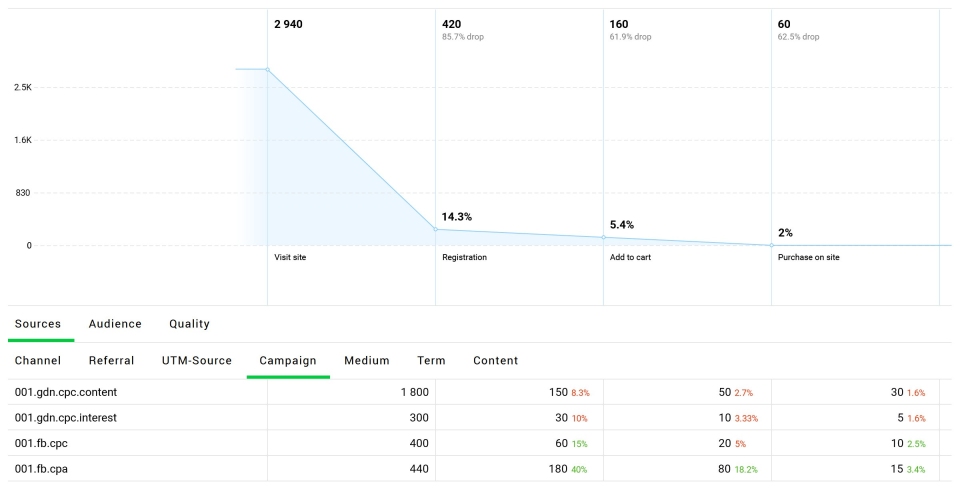Your crucial business decisions depend highly on the quality and authenticity of your web analytic reports. For that, you must comprehensively review your website analytics using various tools and tactics.
Web analytics audit by professional analytics consultants helps you generate substantial profits by implementing marketing strategies and enables you to utilize your ad spending better and more efficiently.
This article will explain the importance of web analytics audits and how you can conduct a successful audit to maximize your ROI and improve your efficiency.
Let’s begin!
What is a Web Analytics Audit?
Web Analytics is a comprehensive process of reviewing and altering the web analytics settings to maximize your returns and profits to meet your marketing goals.
It filters incorrect tracking codes, internal traffic, bounce rates, and spam sessions. It includes setting up defined goals with conversion rate tracking to meet your ROI goals.
For this, web analytic attribution models are set up to recognize the exact pages, products, and channels that direct toward the sales.
Overall, auditing your generated data helps you make better business decisions, resulting in higher profits and an increased bottom line.
Why is Web Analytics Audit Important?
Here are the reasons why you should conduct a time web analytics audit:
- Website analytics audits help you identify loopholes and find new opportunities for the betterment of your site.
- It helps you recognize the errors in tracking code implementation and lets you track your ROI and ad spending to minimize your cost.
- An efficient web analytic audit will help you enhance the quality of your sales and marketing team by identifying the KPIs helping you to improve your productivity.
- Identifying and rectifying the weaklings of the report through the audit at the right time helps decision-makers easily understand your analytics.
- Web analytics audit helps maintain high-quality content and gives you the surety to present your analytical data more confidently in front of investors and stakeholders.
How to Capture Data for a Web Analytics Audit?
Here are the steps to capture data for a comprehensive analytics audit:
Collecting at Source Code Level
Capturing data at source level quicker. It is as simple as viewing the source code and finding a javascript call for your analytics. You can check your page’s source code by using the shortcut CTRL+U.
The page will look as shown below. You only need to worry about hiring a web analytic auditor who holds a firm grip over javascript to read and understand the codes and simplify for you to apply optimization for the betterment of your website.
Tracking Data with Analytics Tools
Using this approach to capture data for analytics audit is easy as you outsource the technical part of data collection to an online tool. You only need to carefully review and choose the perfect analytic tool for your website.
It measures your traffic quality, bot traffic, and daily visitor analysis for you to audit your website and improve the weak ends and user experience to increase lead generation and customer base.
You can use website analytics tools to automate the data collection process for comprehensive audits. There are advanced web analytics tool that identifies 12 types of bad traffic and provides real-time site statistics.
You can also optimize your adverts to maximize your ROI.
With the help of conversion funnels, you can see the entire user conversion path from the first visit to the purchase.
Need help to conduct a web analytics audit and improve your website performance?
Contact Growth Hackers
Web Analytics Audit Checklist
Here is a checklist for your web analytics audit:
1. Check track code implementation
Implementing a tracking code ensures that all the pages on your website are tracked in order.
It can be done via two effective methods:
- By using the Google Tag Assistant Chrome extension
- By using the developer tool on your website
2. Check if the URL is set up correctly
Another thing to be checked is whether the default URL is in your view settings. This should always be the same as your homepage address, and remember to select SSL(HTTP/HTTPS) correctly.
3. Check if bot traffic is excluded
Bot traffic refers to non-human traffic that is usually generated by robots. You need to check whether the analytical reports have excluded this traffic.
If not, you can do it manually if your analytic tools have this feature.
4. Validate data in real-time reports
Real-time reports give you an idea of whether your tracking codes are working fine or not. This report includes the current number of visitors on your site with the information on the specific page, location, events, and conversions.
5. Check if website search settings are enabled
By ensuring that your website search settings are enabled, you can quickly identify the search terms used by your website visitors for further keyword optimization.
6. Check if the goals are set up correctly
Checking up on your pre-defined goals helps you track your activities and better understand your current position and how you can improve it. You can set goals when a visitor completes a purchase or a particular page is viewed.
7. Check if your website has been added to your referral exclusion list
You must ensure that your website has been added to the referral exclusion list. This helps filter and eliminate the referral derived from your domain.
8. Evaluate if interest reports and demographics are enabled
Interest and demographic reports of the visitors provide detailed information about the age, gender, and taste of the visitors. This helps you better understand the interest of internet users.
You need to check whether you have enabled the feature of collecting this data or not. If not, make sure to change the settings in your analytic tool.
9. Check whether the correct hostname has been captured in your reports
Evaluate the report carefully to ensure that your correct domain is captured correctly with SSL to troubleshoot cross-domain strategy and traffic anomalies. If other domain names appear in your technical reports, you must create an exclude filter to eliminate this traffic.
10. Check if any personal information is captured in your reports
You need to avoid including any personal information in your analytic reports. This information includes email address, phone number, SSN, etc.
Search engines are very strict with their terms and conditions pertaining to personal information, so if your reports have captured any such information, your account will likely be blocked or suspended.
Achieve your online goals by conducting a web analytics audit today!
11. Check if currency and time zone are setup correctly
You should check if the time zone and currency are selected correctly in your view settings.
Web analytics tools offer you the advantage of adjusting time zones per visit and viewing helpful websites operating in various time zones.
12. Check if e-commerce is enabled in the settings
You will likely miss out on transactional data if your settings are e=commerce disabled.
By enabling e-commerce in your web analytic tool, you can generate e-commerce reports that contain important decision taking elements. It provides insight to optimize your online store.
Key metrics of your e-commerce store will include the percentage of site visits, the total number of purchases on your website, the average amount of revenue by each order, the number of times a particular product is in a transaction, and more.
You should implement the tracking by placing additional tracking code snippets in your website’s code to collect in-depth information about your site’s transactions.
13. Enable and configure raw view, master view, and test view
Views in a web analytic tool are a subset of a property. These views help you sieve out the data you want to analyze.
The views are segregated into three major categories.
The raw view is a website data view without any filters and exclusions. You should avoid making changes to this view and keep it intact. Whenever you doubt your filters, you should turn your settings to raw view, which enables the default view.
Then comes the test view, which is used to test out any filters and see how they affect the collected traffic. Once a particular filter works for you in the test view, you can apply it in the master view.
The master view is the analytic view you see every day to check your website performance. Ideally, this view should be enabled with exclusions of internal traffic, bot traffic, and referrals. Key business should be based on the data gathered in this view.
14. Configure consumer behavior reports
Enabling consumer behavior reports in your settings helps you gather information about how your customers behave on a particular page (e.g. number of page views, bounce rate, landing and exit pages).
There is plenty of data on your website and configuring behavior reports on your analytic tool helps you get a clearer insight into an individual page’s performance.
15. Configure conversion reports
You need to keep a check on whether the goals you have set up are turning into valuable conversions or not. You can check your website’s performance based on your goals by configuring conversion reports.
This will generate what attracts customers to your website and how many visitors are turning into conversions. Analyze the reports carefully, as this will help identify your macro and micro goals.
After identifying the critical conversion areas and lowest conversion parts, you should review already set-up goals and implementations.
Final Thoughts About Conducting a Web Analytics Audit
It’s a tedious and lengthy task to conduct a perfect audit. To ease your work, I have listed how you can perform the web analytics audit smoothly, saving you time and effort.
For successful marketing campaigns, conducting an analytics audit is the first step in maximizing your return on investment.
Planning plays a significant role in performing an audit and ensuring you can repeat the process. Read the above-listed steps carefully before performing your audit to know what needs to be done and what to avoid.
Growth Hackers is surely one of the best B2B web design agencies helping businesses from all over the world grow. There is no fluff with Growth Hackers. We help entrepreneurs and business owners conduct web analytics audit, generate qualified leads, optimize their conversion rate, gather and analyze data analytics, acquire and retain users and increase sales. We go further than brand awareness and exposure. We make sure that the strategies we implement move the needle so your business grow, strive and succeed. If you too want your business to reach new heights, contact Growth Hackers today so we can discuss about your brand and create a custom growth plan for you. You’re just one click away to skyrocket your business.








